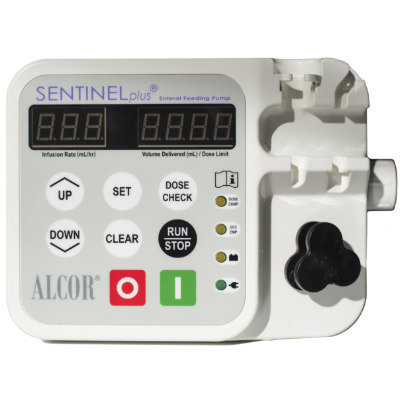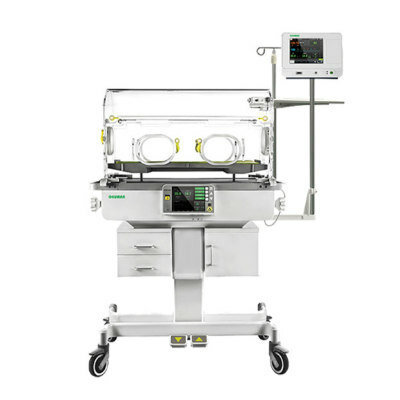Wearable Health Tech Could Measure Gases Released From Skin to Monitor Metabolic Diseases
|
By HospiMedica International staff writers Posted on 02 May 2022 |

Most research on measuring human biomarkers, which are measures of a body’s health, rely on electrical signals to sense the chemicals excreted in sweat. But sensors that rely on perspiration often require huge amounts of it just to get a reading. Now, a new study suggests that a wearable sensor may be able to monitor the body’s health by detecting the gases released from a person’s skin.
Scientists at The Ohio State University (Columbus, OH, USA) have taken the first step to creating the next generation of wearable health monitors. Some wearable devices, like smartwatches or fitness trackers, are already capable of measuring pulse rates or temperatures, but this team’s method would allow the technology to sense biomarkers related to metabolic disorders, like heart disease or diabetes. The final product of the team’s research would be a small device a person could wear on low-sweat body locations, like behind the ear or on the nails. And as more people become familiar with using wearable devices in their everyday lives, the team expects technology and medicine to become even more intertwined.
Scientists have a long history of measuring the concentration of organic compounds in our breath - a type of gas - as indicators of health. One example would be blowing into a breathalyzer, a device which can measure the amount of alcohol in a person’s blood or be used to detect viruses. But such a gadget requires “active intent” and only provides a “momentary snapshot” of the body. Compared to the amount of chemicals we release when we breathe, this team’s sensors can operate on much smaller amounts of gaseous acetone released from the skin. Acetone is one of the substances secreted from the skin that can tell researchers a lot about the inner workings of the human body. Concentrations of acetone in the breath have also been shown to be related to blood sugar levels and fat-burning rates.
To test whether their sensors could detect varying amounts of these enlightening chemicals (which would signal the presence of the gaseous molecules), the researchers created a film material made out of derivatives of plant cellulose and electroactive polymers. This film can bend dramatically in response to how much of the acetone is detected in its environment. The team then placed the film over solutions containing ethanol (alcohol), acetone and water to gauge its sensitivity, selectivity and repeatability.
The researchers found a significant bias toward bending more upon exposure to certain chemicals over others. This bending happens in milliseconds, and the researchers used machine learning and complex computational algorithms to accurately record and track the film’s bending response to the different chemical solutions. Their findings showed that the films are sensitive enough to track long-term changes in the body. While focusing on a metabolic rate sensor, another possible use would be to track ethanol which, in the body, can spell signs of liver disease. More work needs to be done on how the films used in this study would work as actual sensors worn on the body, the researchers said.
“It is completely non-invasive, and completely passive on the behalf of the user,” said Anthony Annerino, lead author of the study and a graduate student in materials science and engineering at The Ohio State University. “This is an area of research that hasn’t been nearly as well developed yet, because we’re just now producing the technology to measure lower concentrations of these gases with high selectivity.”
“We are developing a new generation of skin sensors, and it will really be the new norm,” said study co-author Pelagia-Iren Gouma, professor of materials science and engineering. “The project still has a couple of years to go. But in six months, we should have proof of concept and in a year, we’d like to have it tested in people.”
Related Links:
The Ohio State University
Latest Health IT News
- Machine Learning Model Improves Mortality Risk Prediction for Cardiac Surgery Patients
- Strategic Collaboration to Develop and Integrate Generative AI into Healthcare
- AI-Enabled Operating Rooms Solution Helps Hospitals Maximize Utilization and Unlock Capacity
- AI Predicts Pancreatic Cancer Three Years before Diagnosis from Patients’ Medical Records
- First Fully Autonomous Generative AI Personalized Medical Authorizations System Reduces Care Delay
- Electronic Health Records May Be Key to Improving Patient Care, Study Finds
- AI Trained for Specific Vocal Biomarkers Could Accurately Predict Coronary Artery Disease
- First-Ever AI Test for Early Diagnosis of Alzheimer’s to Be Expanded to Diagnosis of Parkinson’s Disease
- New Self-Learning AI-Based Algorithm Reads Electrocardiograms to Spot Unseen Signs of Heart Failure
- Autonomous Robot Performs COVID-19 Nasal Swab Tests

- Statistical Tool Predicts COVID-19 Peaks Worldwide
- Wireless-Controlled Soft Neural Implant Stimulates Brain Cells
- Tiny Polymer Stent Could Treat Pediatric Urethral Strictures
- Human Torso Simulator Helps Design Brace Innovations
- 3D Bioprinting Rebuilds the Human Heart
- Nanodrone Detects Toxic Gases in Hazardous Environments
Channels
Artificial Intelligence
view channel
AI-Powered Algorithm to Revolutionize Detection of Atrial Fibrillation
Atrial fibrillation (AFib), a condition characterized by an irregular and often rapid heart rate, is linked to increased risks of stroke and heart failure. This is because the irregular heartbeat in AFib... Read more
AI Diagnostic Tool Accurately Detects Valvular Disorders Often Missed by Doctors
Doctors generally use stethoscopes to listen for the characteristic lub-dub sounds made by heart valves opening and closing. They also listen for less prominent sounds that indicate problems with these valves.... Read moreCritical Care
view channel
Deep-Learning Model Predicts Arrhythmia 30 Minutes before Onset
Atrial fibrillation, the most common type of cardiac arrhythmia worldwide, affected approximately 59 million people in 2019. Characterized by an irregular and often rapid heart rate, atrial fibrillation... Read more
Breakthrough Technology Combines Detection and Treatment of Nerve-Related Disorders in Single Procedure
The peripheral nervous system (PNS) serves as the communication network that links the brain and spinal cord to every other part of the body. It consists of two parts: the somatic nervous system, which... Read moreSurgical Techniques
view channel
Hydrogel-Based Miniaturized Electric Generators to Power Biomedical Devices
The development of engineered devices that can harvest and convert the mechanical motion of the human body into electricity is essential for powering bioelectronic devices. This mechanoelectrical energy... Read moreWearable Technology Monitors and Analyzes Surgeons' Posture during Long Surgical Procedures
The physical strain associated with the static postures maintained by neurosurgeons during long operations can lead to fatigue and musculoskeletal problems. An objective assessment of surgical ergonomics... Read more.jpg)
Custom 3D-Printed Orthopedic Implants Transform Joint Replacement Surgery
The evolving field of 3D printing is revolutionizing orthopedics, especially for individuals requiring joint replacement surgeries where traditional implants fail to provide a solution. Although most people... Read more
Cutting-Edge Imaging Platform Detects Residual Breast Cancer Missed During Lumpectomy Surgery
Breast cancer is becoming increasingly common, with statistics indicating that 1 in 8 women will develop the disease in their lifetime. Lumpectomy remains the predominant surgical intervention for treating... Read moreHealth IT
view channel
Machine Learning Model Improves Mortality Risk Prediction for Cardiac Surgery Patients
Machine learning algorithms have been deployed to create predictive models in various medical fields, with some demonstrating improved outcomes compared to their standard-of-care counterparts.... Read more
Strategic Collaboration to Develop and Integrate Generative AI into Healthcare
Top industry experts have underscored the immediate requirement for healthcare systems and hospitals to respond to severe cost and margin pressures. Close to half of U.S. hospitals ended 2022 in the red... Read more
AI-Enabled Operating Rooms Solution Helps Hospitals Maximize Utilization and Unlock Capacity
For healthcare organizations, optimizing operating room (OR) utilization during prime time hours is a complex challenge. Surgeons and clinics face difficulties in finding available slots for booking cases,... Read more
AI Predicts Pancreatic Cancer Three Years before Diagnosis from Patients’ Medical Records
Screening for common cancers like breast, cervix, and prostate cancer relies on relatively simple and highly effective techniques, such as mammograms, Pap smears, and blood tests. These methods have revolutionized... Read morePoint of Care
view channel
Critical Bleeding Management System to Help Hospitals Further Standardize Viscoelastic Testing
Surgical procedures are often accompanied by significant blood loss and the subsequent high likelihood of the need for allogeneic blood transfusions. These transfusions, while critical, are linked to various... Read more
Point of Care HIV Test Enables Early Infection Diagnosis for Infants
Early diagnosis and initiation of treatment are crucial for the survival of infants infected with HIV (human immunodeficiency virus). Without treatment, approximately 50% of infants who acquire HIV during... Read more
Whole Blood Rapid Test Aids Assessment of Concussion at Patient's Bedside
In the United States annually, approximately five million individuals seek emergency department care for traumatic brain injuries (TBIs), yet over half of those suspecting a concussion may never get it checked.... Read more
New Generation Glucose Hospital Meter System Ensures Accurate, Interference-Free and Safe Use
A new generation glucose hospital meter system now comes with several features that make hospital glucose testing easier and more secure while continuing to offer accuracy, freedom from interference, and... Read moreBusiness
view channel
Johnson & Johnson Acquires Cardiovascular Medical Device Company Shockwave Medical
Johnson & Johnson (New Brunswick, N.J., USA) and Shockwave Medical (Santa Clara, CA, USA) have entered into a definitive agreement under which Johnson & Johnson will acquire all of Shockwave’s... Read more
















